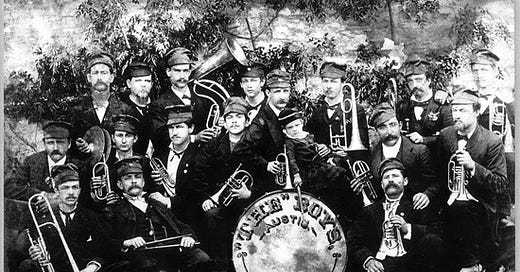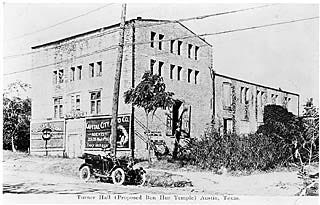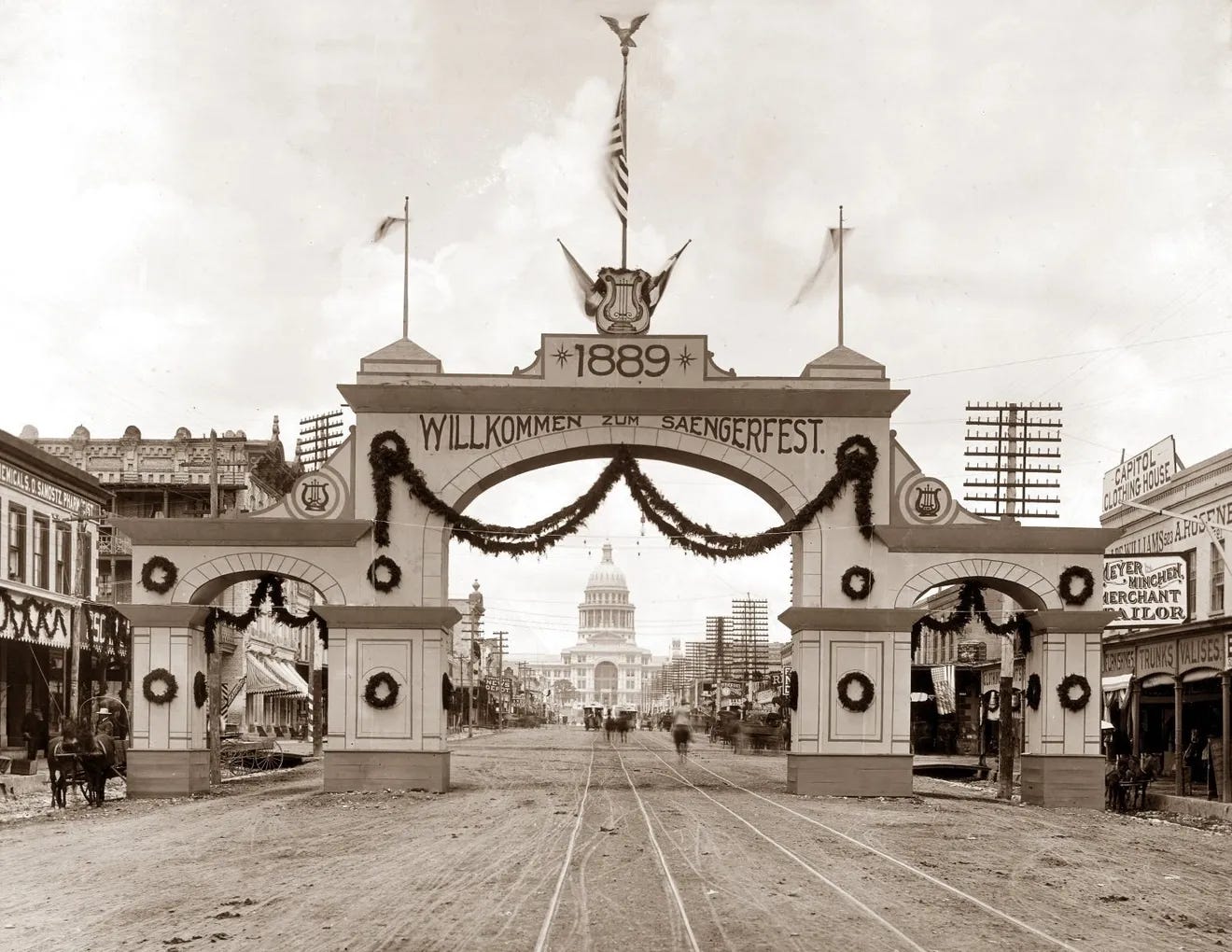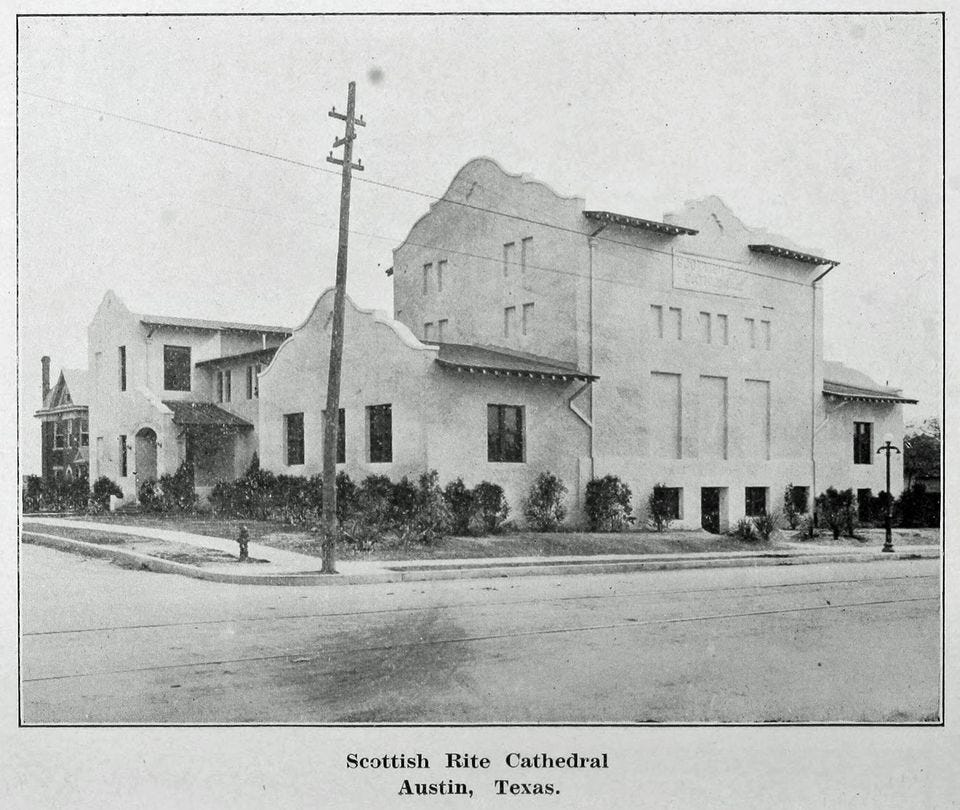Austin's oldest standing music venue is 150 years old
German singing societies met at Turner Hall in 1872. Today it's the Scottish Rite Theater.
Liberty Lunch- bulldozed. Armadillo- gone. Soap Creek- not a trace. Charlie’s Playhouse and the Skyline and the Split Rail and the original Antone’s- all wiped off the face of Austin to make way for office buildings, parking lots, condos and other boring shit. Workers at One Texas Center park their stupid cars where Jimmy Cliff once sang “The Harder They Come” for an audience which had never heard live reggae before.
But one of the city’s first live music venues- beating Millett Opera House (the Austin Club today) by six years- is still standing.
Turner Hall was built in 1872 by the Turn Verein social and athletic club. It was one of many halls erected in Texas by German and Czech immigrants in the years between the Civil War and World War I to help keep their cultural identity alive. Many of the plays and operas staged at Turner were in German.
Since 1914, that limestone edifice on Lavaca St. at 18th has been home to the Scottish Rite Theater.
Designed by San Antonio mayor C.A. Thielepape, Turner Hall had a capacity of 400 inside and a couple thousand more in the back biergarten, in the shadow of the state Capitol, which burned down in 1881. You could have a beer at Turner and watch it being rebuilt, which took seven years.
Turn comes from “turnen,” which means to practice gymnastics. Verein is German for “club,” so physical fitness was a big part of Turner Hall (a common Americanization), which had a gymnasium and a bowling alley.
Turner Hall became more easily accessible in 1874 when Austin’s mule drawn trolley system extended lines down Lavaca to the venue. Turner’s Saloon opened in the basement in 1885.
Scholz Garden was built earlier, 1866, and occasionally hosted musical events, but it was primarily a restaurant/bar, not a dedicated venue. The Austin Saengerrude vocal group met at Turner every Thursday because their own hall, next to Scholz’s wouldn’t be built until 1879. Turner was also home to the Austin’s Maennerchor Society, a men’s choir that would also relocate to Saengerrunde Hall.
The very first music venue in Austin was Buaas Garden on the E. 400 block of Pecan (Sixth Street), which opened six years before Scholz’s, but was cleared in 1874 to make way for buildings that are still there. The middle one was home of rock club Steamboat 1874 from ‘78- ‘99. John L. Buaas was the stepfather (since age 2) of William Besserer, who would go on to be Austin’s John Phillip Sousa. Buaas sent him to Germany as a teenager to be trained by future New York Philharmonic leader Leopold Damrosch.
Besides owning a musical instrument store with Buaas, Besserer was active at Turner Hall since the beginning. According to Limestone to Legacy, Gordon W. Kelso’s essential history of the building, one of the first big productions at Turner was “Laila,” a three-act operetta featuring 40 students from Austin Female College under the direction of Besserer. In 1873, he married the daughter of August Scholz (who called his place “Garden,” not “Garten”). After Scholz died in 1891, the Besserers inherited Scholz’s, but sold it after a few years so William could dedicate himself to music. The Austin Saengerrunde has owned Scholz’s since 1908. Still popular today, it’s the oldest operating business in Texas.
Besserer conducted the first local orchestra to play a complete symphony in 1911, which led to the creation of the Austin Symphony two years later.
Though Besserer is considered “the Father of Austin Music,” many considered pianist Edmund Ludwig, whose Conservatory of Music trained many at 301 E. 14th St., its finest musician. He went against the town’s classical music establishment, however, in 1897, when he canceled a concert at the Millett Opera House because segregation was practiced- with Blacks in the balcony. The scheduled dual piano recital was with African-American Maud Cuney, the head of the music department for the Texas Institute of Deaf, Dumb, Blind Colored Youth on Bull Creek Road. When Cuney made Ludwig aware of the seating inequality, they held the concert at the Black blind school instead. In attendance was an 8-year-old student named Arizona Dranes, who would go on to pioneer “the gospel beat,” with piano-driven recordings on OKeh Records in 1926.
Go here to read more about the remarkable life of Maud Cuney-Hare.
Austin’s first two great musicians, Edmund Ludwig (1858- 1909) and Carl William Besserer (1851-1931), are both buried at Oakwood Cemetery.
Turner Hall was prominent in the 1889 Saengerfest, a German singing celebration which rotated each year between New Braunfels, San Antonio, Galveston and Austin. The Austin Daily Statesman covered the hometown’s turn like it would later obsess over SXSW and ACL Fest.
"This will be one of the grandest displays Austin has ever had," the Statesman correctly predicted on 4/13/1889. Saengerfest’s motto was German for "When men sing there are no bad men, for bad men have no song."
The fest opened 4/22/89 with a torchlight procession up Pecan (Sixth) St. and down Congress towards the brand new state Capitol. Every business along the route decorated its facade in lights. The parade, which featured two marching bands and Governor Sul Ross, followed the streetcar tracks to Turner Hall, where a smaller arch on Lavaca marked the end of the procession.
The Statesman writer was in top form, describing that, "...the blare of music, the tramp of marching men and the shifting line of torches formed one panoramic phastasmagoria, beautiful to contemplate, grand to behold and pleasant to remember." The banquet at Turner Hall found "long tables fairly groaned beneath the burden of delicacies."

The Saengerfest concluded April 24 with a picnic concert under the live oaks at Pressler's Garden (1327 W. Sixth) during the day and, at night, a grand ball at Turner Hall, featuring a 40-piece orchestra of German musicians from around the state, organized and led by Besserer.
Schools closed early that day so families could go to Pressler’s, a former brewery with a bandstand in the middle of beautifully landscaped grounds that extended south to the river.
Here’s the Statesman again: “He who could not find pleasure in such surroundings has no place on Earth- Heaven’s his home.”
Once with 175 members, Turn Verein was down to 40 in 1886 when Congress Avenue hardware store owner Walter Tips, who assumed the loan to build Turner Hall, sold the building to Professor J. Alleine Brown of Brenham, who would later serve as president of the Texas State Teachers Association. There was talk of converting Turner into a dorm for students of University of Texas, which opened in 1883, but nothing came of that. Brown sold Turner Hall in 1892. This information comes from Limestone to Legacy, which you can read in its entirety here.
Turner Hall fell into disrepair at the turn of the 20th Century, with Saengerrude Hall and the Hancock Opera House (1898) hosting most of the German musical and indoor athletic events. It was sold in 1912 to Ben Hur Temple, who moved it just two years later to the Scottish Rite folks, who conducted a massive renovation.
But Turner Hall is still there. You just can’t see it any more.
For more Austin history, read Richard Zelade’s fun and informative blog.







Thank you, Michael, for your kind words about my blog, The Austin Blunderbuss, and for all your work documenting Texas music history!
There's a pretty decent picture of the music hall as it is today here -> https://scottishritetheater.org/rentals/